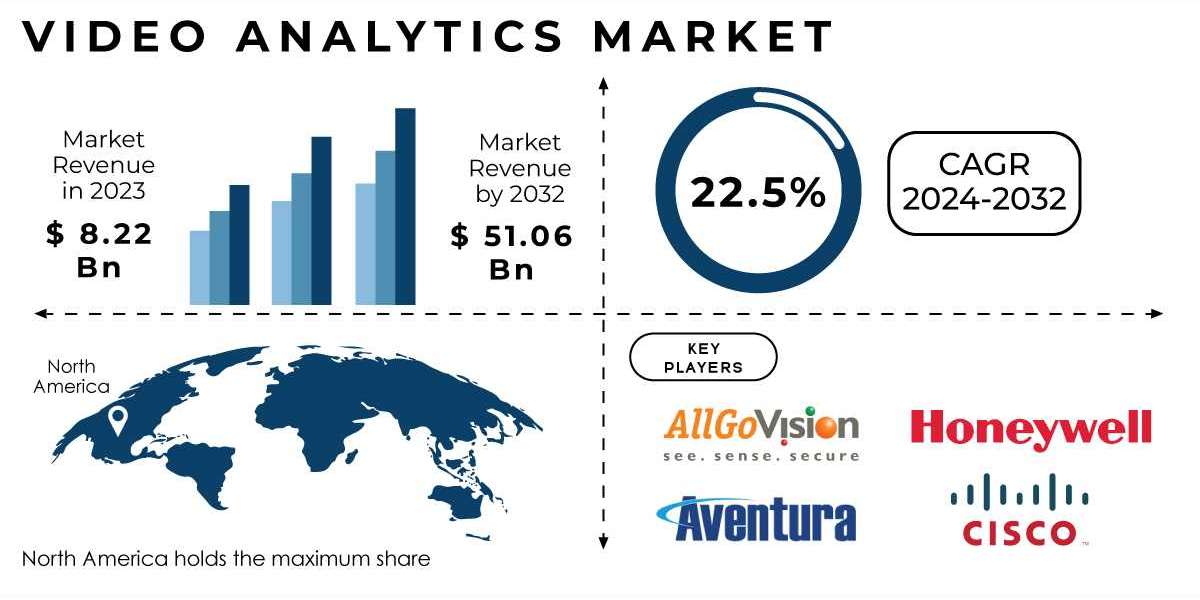Video Analytics 2024
In an era dominated by data-driven decision-making, video analytics has emerged as a transformative technology that leverages artificial intelligence (AI) and machine learning to extract actionable insights from video content. This innovative approach not only enhances security and surveillance but also facilitates improved operational efficiency across various industries, including retail, transportation, and healthcare. The Video Analytics Market Growth reflects this burgeoning trend, with a market size valued at USD 8.12 billion in 2023 and projected to reach USD 50.31 billion by 2032, growing at a CAGR of 22.51% over the forecast period from 2024 to 2032.
Understanding Video Analytics
At its core, video analytics involves the automatic analysis of video footage to identify patterns, trends, and specific events. This process is powered by advanced algorithms capable of detecting motion, recognizing faces, and interpreting various behaviors in real-time. Traditional video surveillance systems primarily rely on human monitoring, which is labor-intensive and prone to error. In contrast, video analytics automates this process, enabling organizations to monitor large volumes of video data efficiently and accurately.
The technology encompasses a range of functionalities, including object detection, intrusion detection, and activity recognition. For instance, in retail environments, video analytics can track customer movement patterns, allowing businesses to optimize store layouts and enhance customer engagement. In security applications, it can provide alerts for unauthorized access or suspicious behavior, significantly improving incident response times.
Key Applications of Video Analytics
One of the most significant applications of video analytics is in the realm of security and surveillance. Law enforcement agencies and private security firms leverage this technology to enhance public safety. By employing facial recognition algorithms, they can quickly identify individuals of interest from vast databases, enabling faster investigations and increased deterrence against criminal activities.
In the retail sector, businesses utilize video analytics to gain insights into customer behavior. By analyzing foot traffic patterns and dwell times in specific areas, retailers can make informed decisions about product placement and promotions. This data-driven approach not only enhances customer satisfaction but also drives sales growth. Additionally, video analytics can help identify peak shopping hours and optimize staffing levels, leading to improved operational efficiency.
Moreover, transportation and logistics companies are increasingly adopting video analytics to enhance safety and streamline operations. In fleet management, video footage can be analyzed to monitor driver behavior, ensuring compliance with safety regulations and reducing accidents. Similarly, airports and public transport systems use video analytics to monitor passenger flow, identify bottlenecks, and enhance security measures.
Challenges in Implementing Video Analytics
Despite its numerous advantages, implementing video analytics is not without challenges. One of the primary concerns is the privacy implications associated with widespread surveillance. Organizations must navigate complex regulations surrounding data protection and ensure that they implement video analytics solutions responsibly. Failure to address these issues can lead to legal repercussions and damage to brand reputation.
Additionally, integrating video analytics into existing security systems can be technically complex. Organizations may face compatibility issues with legacy equipment, requiring significant investment in upgrading infrastructure. Ensuring data accuracy and minimizing false positives are also critical challenges that need to be addressed to maximize the effectiveness of video analytics solutions.
The Future of Video Analytics
As technology continues to advance, the future of video analytics appears promising. The integration of AI and machine learning algorithms will enable even more sophisticated analysis capabilities, allowing organizations to derive deeper insights from their video data. Furthermore, the rise of edge computing will facilitate real-time processing of video feeds, reducing latency and enhancing responsiveness.
In addition, the growing adoption of smart city initiatives is expected to drive the demand for video analytics solutions. As cities become increasingly interconnected, the need for advanced surveillance and traffic management solutions will grow. Video analytics can play a crucial role in enhancing urban safety, optimizing traffic flow, and improving overall quality of life for residents.
In conclusion, video analytics stands at the forefront of technological innovation, offering organizations powerful tools to enhance security, optimize operations, and gain insights into consumer behavior. As the Video Analytics Market continues to expand, organizations that embrace this technology will be better positioned to thrive in a rapidly evolving digital landscape. By harnessing the power of video analytics, businesses can not only improve their operational efficiency but also create safer, more responsive environments for their customers and stakeholders.
Contact Us:
Akash Anand – Head of Business Development Strategy
info@snsinsider.com
Phone: +1-415-230-0044 (US) | +91-7798602273 (IND)
About Us
SNS Insider is one of the leading market research and consulting agencies that dominates the market research industry globally. Our company's aim is to give clients the knowledge they require in order to function in changing circumstances. In order to give you current, accurate market data, consumer insights, and opinions so that you can make decisions with confidence, we employ a variety of techniques, including surveys, video talks, and focus groups around the world.
Read Our Other Reports:
Digital Transformation Market Size














